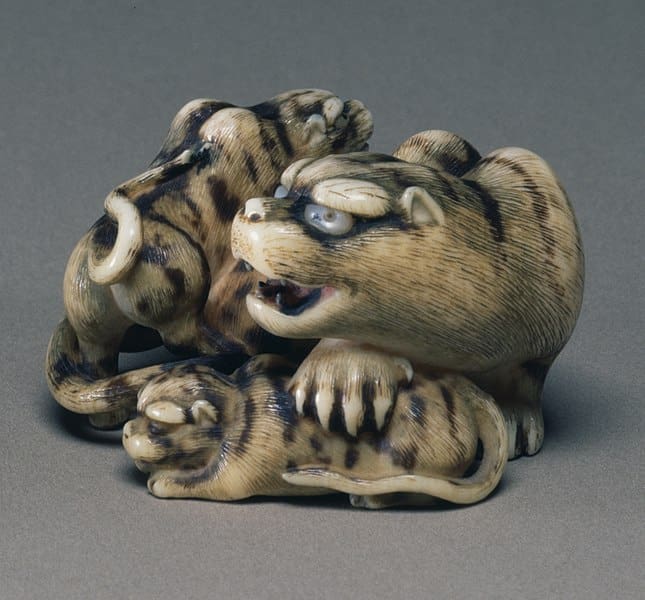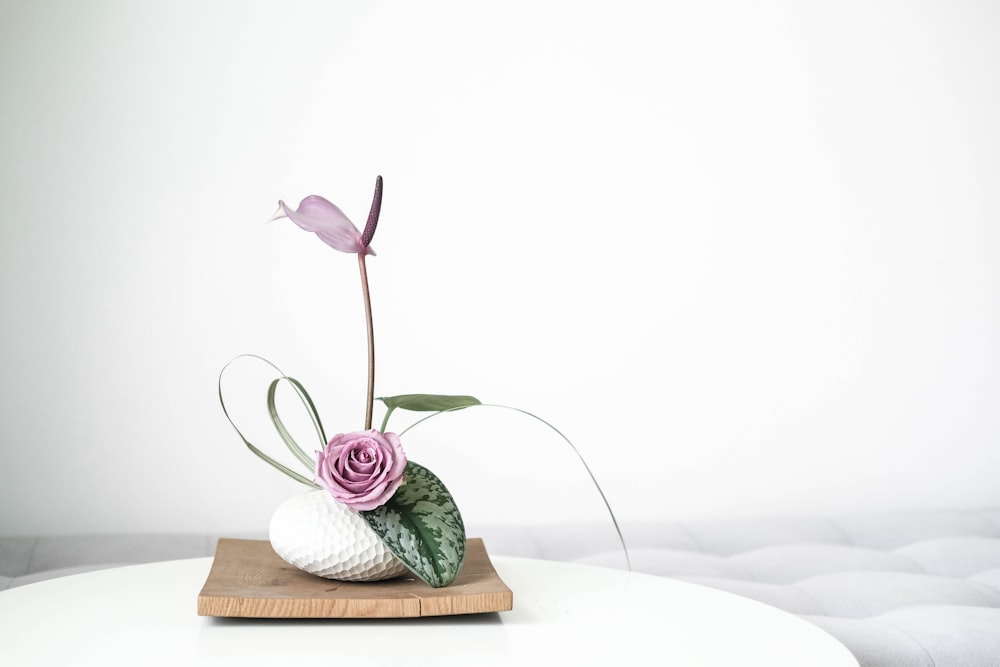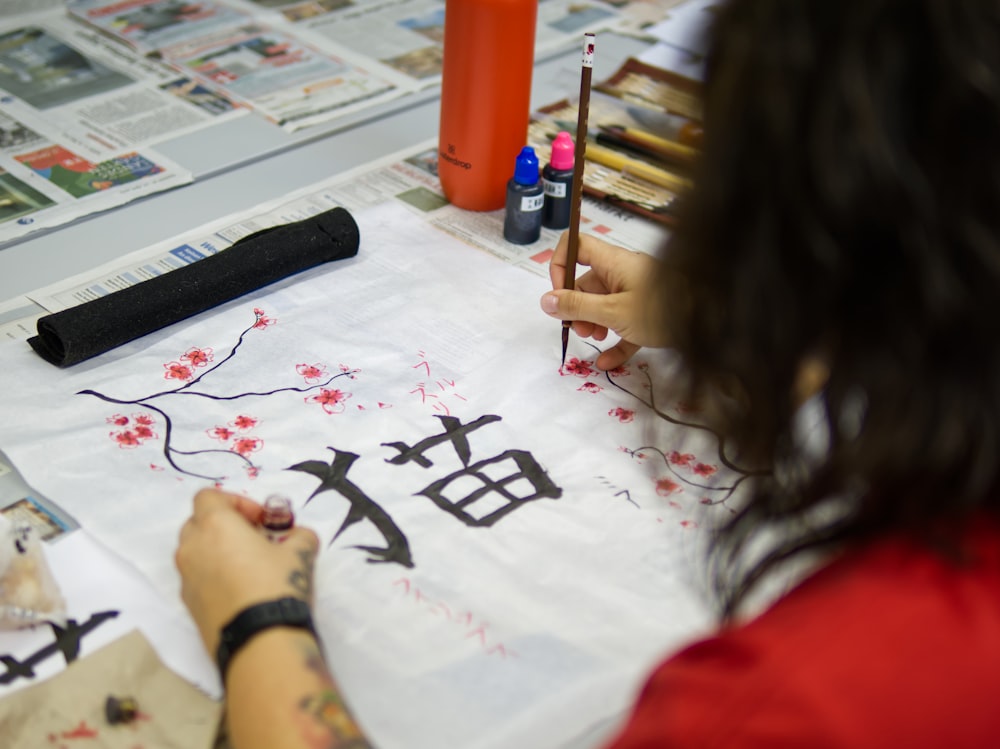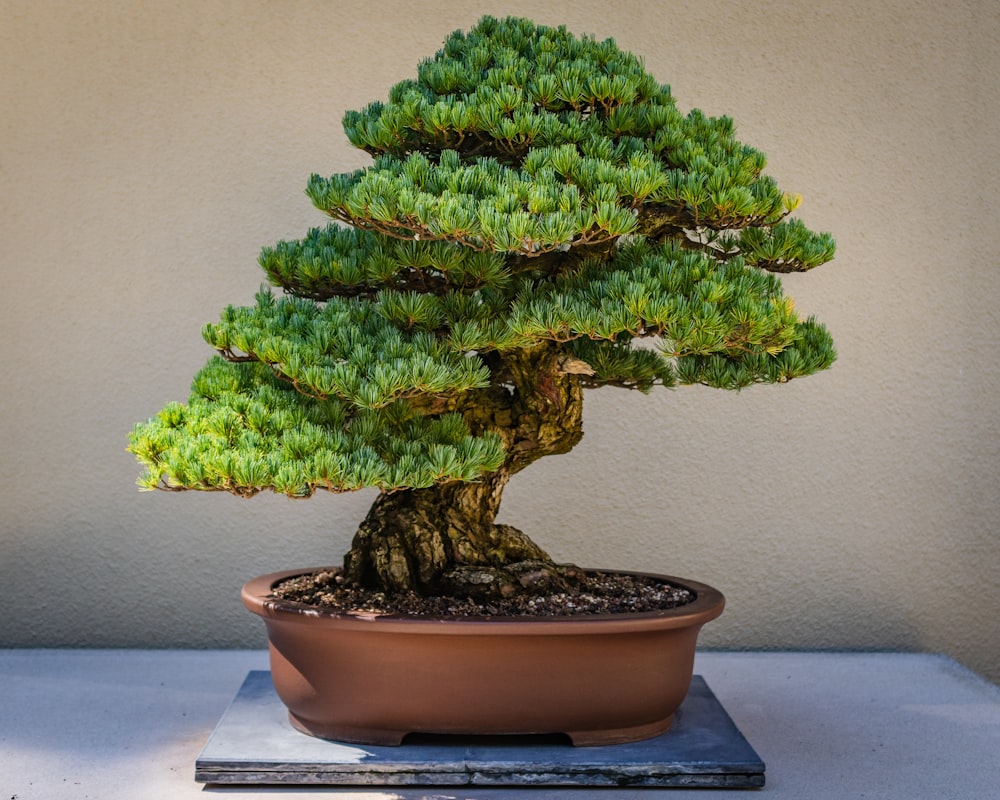20 Fascinating Facts About Traditional Japanese Art
Step into a world where creativity knows no bounds, where every brushstroke, every line, every delicate touch of color holds centuries of tradition and artistic mastery. In the realm of Traditional Japanese Art, a tapestry of captivating stories unfolds through the hands of skilled artisans.
From the serene landscapes of ukiyo-e to the exquisite craftsmanship of tea ceremonies, we’re about to unravel 20 Fascinating Facts About Traditional Japanese Art that will leave you awestruck. From the serene beauty of cherry blossoms in bloom to the mesmerizing intricacies of kimono patterns, each facet of Japanese art has a tale to tell.
1. Traditional Japanese Ukiyo-e Prints art Captures the “Floating World”

Toyohara Chikanobu, Public domain, via Wikimedia Commons
In the illustrious realm of the Edo era, an artistic tradition known as the “floating world” has woven an enchanting tapestry of creativity that continues to captivate hearts and minds to this day. This mesmerizing tradition has given birth to timeless masterpieces, none more iconic than Hokusai’s renowned work, The Great Wave off Kanagawa.
Here, geisha, adorned in vibrant kimono, gracefully dance through the imagination, their presence exuding an aura of elegance that transcends time. Hokusai’s The Great Wave off Kanagawa serves as an enduring testament to the timeless allure of Ukiyo-e. Beyond its visual splendor, this art form possesses an enchanting power – the ability to transport you back to a bygone era, a world waiting to be uncovered with every delicate brushstroke and meticulous carving.
2. Traditional Sumi-e Ink Painting is a Lesson in Simplicity
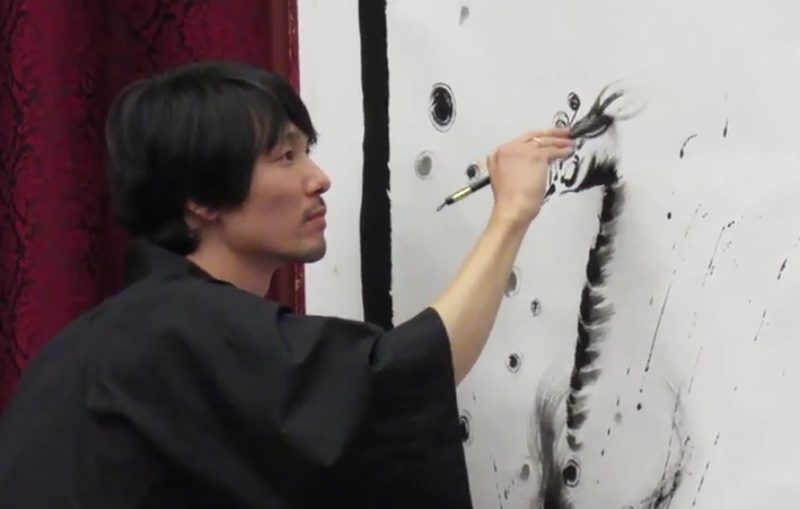
Alarbrand, CC BY-SA 4.0, via Wikimedia Commons
Traditional Sumi-e Ink Painting, hailing from Japan, transcends mere artistic expression; it serves as a profound tutor in the art of cherishing simplicity. Yet, within these unassuming instruments lies the power to conjure awe-inspiring landscapes, fragile blossoms, and remarkably lifelike creatures, all achieved through the alchemy of masterful strokes.
It’s akin to witnessing the very soul of the depicted scene or creature materialize from the confines of the paper. In the realm of art, Sumi-e stands as a testament to the extraordinary outcomes that can emerge from the most basic of resources. The artistry of Sumi-e does not demand an elaborate array of colors or intricate detail; instead, it revels in the eloquence of simplicity.
3. In Traditional Japanese art Kintsugi is the Art of Golden Repair

Ruthann Hurwitz, CC BY-SA 4.0, via Wikimedia Commons
In the realm of Traditional Japanese art, one encounters the enchanting world of Kintsugi, the captivating Art of Golden Repair. Kintsugi, a time-honored practice, masterfully restores shattered pottery to its former glory by employing a unique blend of lacquer, powdered gold, silver, or platinum.
At its essence, Kintsugi represents far more than a mere mending technique. Intriguingly, Kintsugi refrains from concealing the battle scars of pottery; instead, it exalts these cracks and crevices, adorning them with the opulent radiance of precious metals.
4. Experience Harmony in Flower Arrangement through Ikebana
Through the meticulous placement of blossoms and branches, ikebana orchestrates a symphony of harmony and equilibrium, akin to a tranquil Zen garden. In the realm of ikebana, simplicity reigns supreme. This art form, accessible even to those with a rudimentary understanding of botany, prioritizes the use of uncomplicated English words and sentences, rendering it accessible to all, from young schoolchildren to seasoned enthusiasts. Visualize the scene: delicate blooms and slender branches coalesce in a harmonious dance.
5. Origami is the Japanese art of Folding Paper
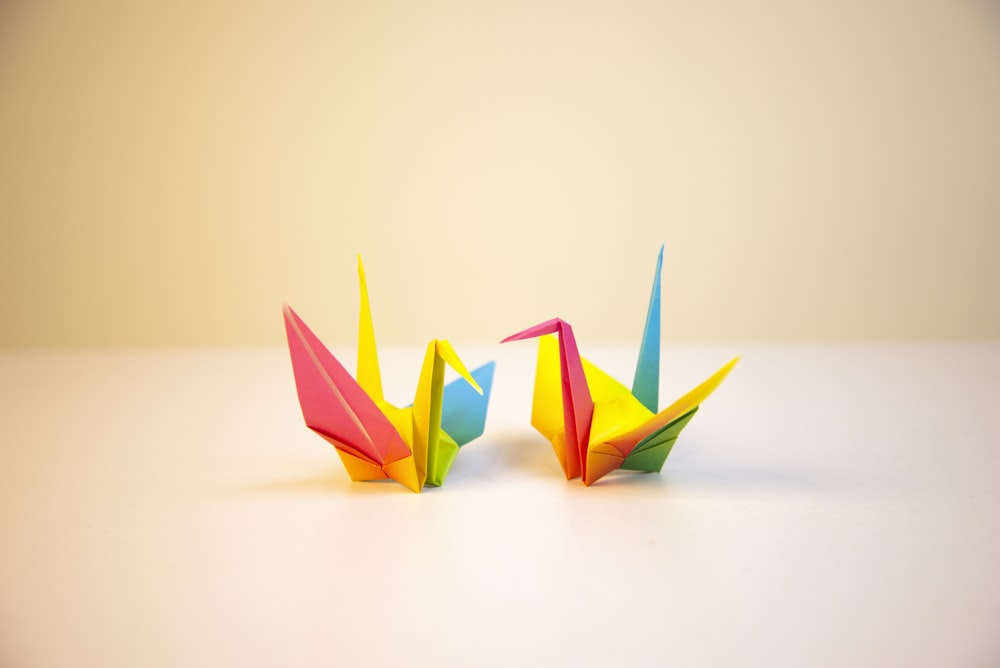
Photo by Carolina Garcia Tavizon on Unsplash
Origami is the captivating Japanese tradition of paper folding. Origami enthusiasts, akin to modern-day sorcerers, work their magic with sheer finesse, their nimble fingers gliding gracefully across the paper’s expanse. With every delicate fold and crease, they summon intricate narratives that transcend the two-dimensional plane of their humble medium.
Picture this: a serene room bathed in soft sunlight, where a solitary artist sits, armed with nothing more than a square sheet of paper and boundless creativity. As the artist’s skilled hands embark on their journey, the paper comes alive, its crisp edges yielding to the touch of practiced fingers. Each fold is a plot twist, each crease a character development, and each completed piece a masterpiece that springs to life within the reader’s mind.
6. Traditional Noh Theater Mask carry Spiritual Significance
Within the enchanting realm of the Noh tradition, masks cease to be mere lifeless artifacts; instead, they metamorphose into living, sentient beings, each harboring its own distinct spirit. When a Noh actor delicately places one of these masks upon their visage, an extraordinary phenomenon unfolds—the actor seamlessly melds their essence with that of the character, as if engaged in an ethereal dance of souls.
The spiritual resonance embodied by Noh masks transcends their mere physicality, discernible even in their meticulous craftsmanship. Each mask, meticulously carved and adorned with intricate paints, is an artful conduit to evoke specific emotions or archetypes.
Take, for instance, the venerable “Okina” mask, which tenderly portrays an aged sage, a symbol of wisdom and enduring life. The act of donning a Noh mask, therefore, transcends the realm of costume changes—it is a profound metamorphosis, a journey into the essence of the character, where actor and mask become one, and the boundaries between the human and the spiritual realm blur in harmonious unity.
7. Japanese Samurai Armor blends Functionality and Beauty
Samurai armor, known as yoroi, embodied both practicality and captivating artistry. Intricately crafted, these yoroi pieces transcended mere utilitarianism. The yoroi’s form and function danced in harmony, offering a dual spectacle of both security and aesthetic delight. Every yoroi, distinct in its own right, serves as a canvas reflecting the social standing and individual character of the wearer.
Picture, for a moment, a samurai adorned in this resplendent armor, a living embodiment of the meeting point between artistry and warfare. One can’t help but marvel at the harmonious blend of form and function embodied by samurai armor. So, next time you encounter a yoroi, remember that it’s not just armor; it’s a window into a world where artistry and combat merged seamlessly, leaving an indelible mark on history
8. Shodo is the Traditional Japanese Art of Japanese Calligraphy
Shodo, the art of Japanese calligraphy, is a mesmerizing dance of brush and ink on paper. In the world of Shodo, each character penned becomes a vessel for profound thoughts and sentiments. From the powerful kanji characters to the elegant hiragana script, every aspect of Shodo is an exploration of the written word.
To practice Shodo, you will need a few basic tools:
- A calligraphy brush: The brush is the most important tool in Shodo.
- Sumi ink: Sumi ink is a traditional Japanese ink made from soot and glue.
- Calligraphy paper: Calligraphy paper is specially designed to absorb ink without bleeding.
Once you have your tools, you are ready to begin learning the basic techniques of Shodo.
9. Haniwa Clay Sculptures hold a Unique place in Ancient Japanese Art History
These exquisite creations, lovingly placed upon tombs during the Kofun period, which spanned from the 3rd to the 6th centuries, cast a captivating glimpse into the tapestry of life from that bygone era. With their simple yet profound elegance, Haniwa figurines have much to reveal about the cultural and artistic heritage of early Japan.
These charming clay works, lovingly formed by skilled hands, cover a spectrum of subjects. Warriors stand sentinel, frozen in time, showcasing the martial spirit of the age. Haniwa sculptures, like time-traveling messengers, whisper stories of an era long past.
10. Raku Ware, Elevates the Tea Ceremony to Art
Developed centuries ago, Raku pottery has withstood the test of time, capturing the imagination of generations of tea enthusiasts. These seemingly unrefined characteristics are, in fact, a deliberate choice, carefully orchestrated to disrupt the structured precision of the traditional tea ceremony. The moment a Raku bowl graces the ceremony, it introduces an element of delightful unpredictability. It’s as though an artist’s brushstroke across a canvas, spontaneous yet purposeful.
Each sip of tea, then, becomes a journey through both time and artistic expression. Intriguingly, Raku pottery’s history is a narrative woven with creativity and tradition. Passed down from generation to generation, it remains an essential component of the tea ceremony’s soul, offering a bridge between the past and the present.
11. Traditional Room Dividers are also Art

Image by Ras67 from Wikimedia
Imagine a world where art is not just confined to walls and canvases, but where it can be folded and unfolded, moved and rearranged. A world where art is not just a static observer, but an active participant in our lives. This is the world of byobu, Japanese folding screens. Byobu are decorative screens that are typically made of wood and paper. Byobu have a long and rich history in Japan, dating back to the Heian period (794-1185). They were originally used in courtly circles, but over time became more popular among the general public.
Byobu are not only functional, but also display the skill and creativity of Japanese artists. Some byobu are also decorated with calligraphy or poetry. Another famous example is the Fujiwara Takayuki Screen, which is now housed in the Tokyo National Museum.
12. Traditional Japanese Netsuke art presents Small but with a big Purpose

Auckland Museum, CC BY 4.0, via Wikimedia Commons
These petite treasures, with their intricate carvings, served a practical purpose during the 17th century in Japan. At that time, traditional Japanese attire lacked the convenience of pockets. To transport their personal belongings like tobacco pouches, seal cases, and inrō (medicine boxes), people ingeniously fastened them to their kimono sashes using cords. Netsuke emerged as the unsung heroes, preventing these cords from slipping and maintaining the integrity of their ensemble. Netsuke became more than functional; they became exquisite expressions of creativity.
13. The Art of Yuzen Dyeing yields Colorful Kimono
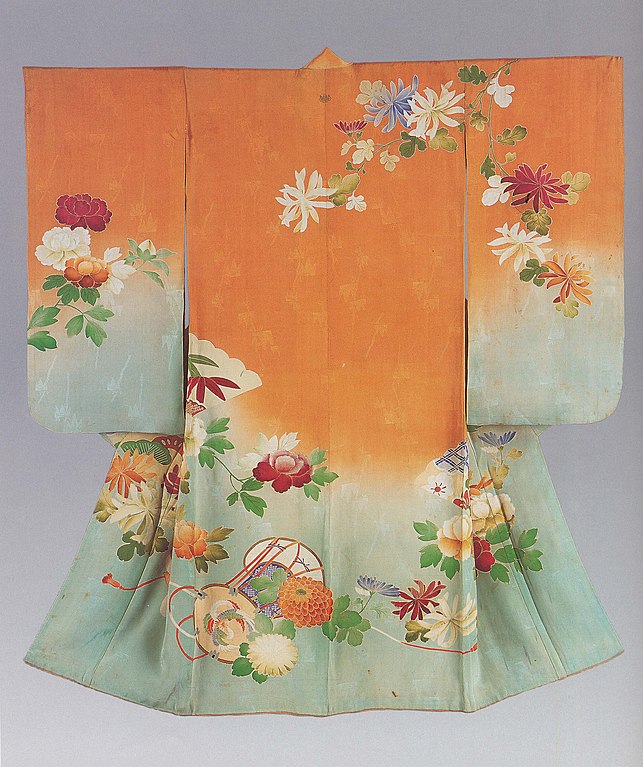
Khalili Collections, CC BY-SA 4.0, via Wikimedia Commons
Following the design phase, a rice paste resist is skillfully applied to those portions of the fabric destined to remain untouched by dye. Subsequently, the fabric undergoes a mesmerizing transformation, with each color being meticulously added one at a time. The result is a harmonious blend of hues, each complementing the next. Once the dyeing process is complete, the rice paste resist is delicately removed, unveiling the true beauty of the design beneath. Picture, for instance, a kimono adorned with cherry blossoms, an emblem of spring and new beginnings in Japanese culture.
14. Traditional Japanese art Celebrates Everyday Life
Ikiyo-e, a captivating subgenre nestled within the enchanting realm of ukiyo-e, is a true celebration of the simplicity and allure of everyday existence. Within the enchanting world of ikiyo-e, artists skillfully weave a narrative that exalts the beauty found in the ordinary. With each stroke of their brushes, they depict scenes of ordinary people engaged in their everyday activities, be it savoring a bowl of steaming ramen at a bustling street vendor’s stall, or quietly contemplating the serene beauty of a cherry blossom tree in bloom.
Ikiyo-e beckons us to appreciate the beauty that surrounds us, hidden in the mundane, and invites us to cherish the everyday, for in those moments lies the true essence of our existence. As we delve deeper into the enchanting world of ikiyo-e, we find ourselves captivated by the art of finding joy in the ordinary, a timeless lesson that continues
15. Yosegi Zaiku: The Art of Geometric Patterns

Eugene Alvin Villar (seav), CC BY-SA 4.0, via Wikimedia Commons
The timeless art of marquetry, akin to the arts and crafts projects you’d find in an elementary school classroom, beautifully melds the comforting embrace of wood with the magic of geometry. Picture in your mind’s eye the skilled hands of a craftsman, gently picking out, cutting, and melding different types of wood, all while following the basic rules of shapes and patterns. What’s the outcome, you ask? It’s a treasure trove of wooden boxes and marvels that fill both youngsters and grown-ups with sheer wonder.
The simplicity of the materials used doesn’t hint at the intricate beauty of the designs they yield. These geometric patterns, stemming from the most basic of shapes, compose a visual masterpiece that enchants everyone who gazes upon them. In the world of marquetry, the very essence of simplicity conceals an elaborate world of artistry and craftsmanship.
16. Stories are Stitched on Cloth in Sashiko Embroidery Art
Picture a blank canvas of cloth, each thread meticulously weaving a narrative of its own, much like a skilled storyteller wielding the language of stitches to relay tales of tradition and ingenuity. Its patterns, like well-guarded secrets, beckon with a sense of mystery, waiting to be delicately unraveled. As you gaze upon the finished creation, you can almost hear the gentle whisper of history intermingled with modern creativity. Its beauty lies not only in the finished product but also in the rhythmic journey of creation. So, pick up a needle, and let your own tale unfurl in the mesmerizing world of Sashiko.
17. Bonsai,the Art of Miniature Trees is World Renown
Originating in China and later refined and embraced by the Japanese, it is a centuries-old tradition that signifies reverence for the natural world and the relentless march of time. Imagine a tree, not as a towering giant in a forest, but as a compact representation of its mature self. In bonsai, this transformation is achieved through careful cultivation and shaping. Each branch is pruned with precision, roots tamed, and branches gently guided with wire, all working in concert to craft a living masterpiece.
The choice of tree species is as diverse as the landscapes they inhabit. Pine, maple, juniper, and ficus, among others, find their place in bonsai pots. Regular watering, meticulous fertilization, and vigilant protection against pests and diseases are all part of the caretaker’s routine. From local exhibitions to international shows, bonsai enthusiasts proudly present their miniature marvels.
18. The Traditional Japanese Art of Maki-e is Highly Decorative

Daderot, CC0, via Wikimedia Commons
Maki-e, an ancient and captivating Japanese art form, can be likened to a mystical ballet of powdered metals gracefully pirouetting across the fluid canvas of wet lacquer, conjuring enchanting masterpieces. Imagine the scene: talented artisans, their hands guided by centuries of tradition, delicately shower powdered gold, silver, or even iridescent mother-of-pearl onto the lacquer’s awaiting surface, birthing a celestial symphony of miniature, glistening stars.
19. Rinpa School: A Riot of Colors and Nature
Every canvas is a mesmerizing symphony of vibrant hues that effortlessly blend, creating a vivid, almost dreamlike spectacle. Picture, if you will, an artist’s palette dipped in the rich, golden hues of a setting sun, casting its warm embrace over tranquil landscapes. Imagine azure blues, reminiscent of clear skies, reflecting in serene ponds adorned with elegant lotus blooms.
This visual tapestry conjures emotions that words struggle to capture – a sense of peace, wonder, and timeless beauty. The Rinpa School doesn’t just paint; it weaves stories with each stroke of the brush.
20. Karakuri Dolls Art has Existed in Japan since the Edo Period
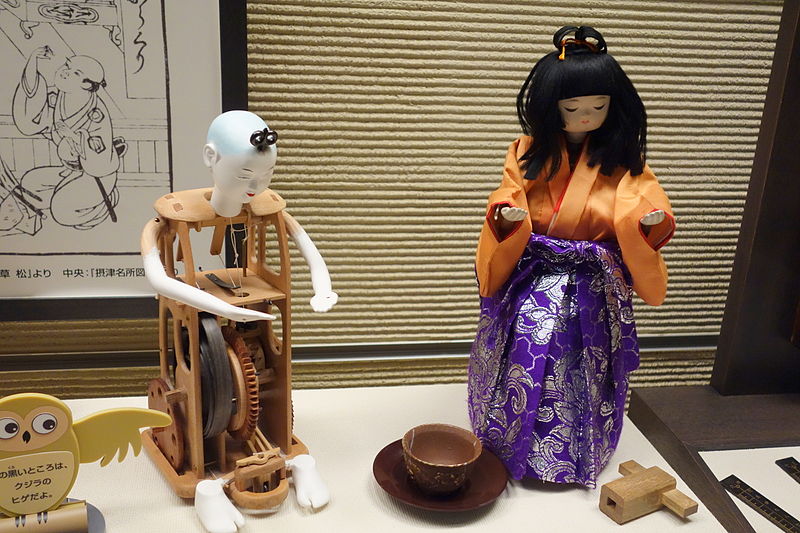
Daderot, CC0, via Wikimedia Commons
In the heart of the Edo period, a remarkable era in Japan’s history, something truly magical came to life: the Karakuri dolls. These charming mechanical marvels, seemingly plucked from the dreams of ingenious artisans, captivate hearts to this day. Imagine a time when the world was a simpler place, yet brimming with innovation. Craftsmen of yore, with their keen eyes and nimble hands, breathed life into these dolls through an intricate web of gears and pulleys.
Picture a Karakuri doll gracefully pouring tea, seemingly guided by an unseen hand, or a playful puppet that dances with effortless grace.
These mechanical wonders are not just relics of the past but living testaments to the rich heritage of Japanese creativity.
Intriguingly, delving into the realm of traditional Japanese art is akin to embarking on a mesmerizing journey through centuries of culture and creativity. From the serene landscapes painted with meticulous detail in ukiyo-e woodblock prints to the profound spiritual significance of the zen garden’s raked pebbles, Japan’s artistry transcends the ordinary, inviting us to contemplate life’s beauty. It’s impossible not to be captivated by the metamorphosis of kabuki theater, where actors’ faces are painted like living canvases, or by the allure of the geisha’s grace and mystery.
Planning a trip to Paris ? Get ready !
These are Amazon’s best-selling travel products that you may need for coming to Paris.
Bookstore
- The best travel book : Rick Steves – Paris 2023 – Learn more here
- Fodor’s Paris 2024 – Learn more here
Travel Gear
- Venture Pal Lightweight Backpack – Learn more here
- Samsonite Winfield 2 28″ Luggage – Learn more here
- Swig Savvy’s Stainless Steel Insulated Water Bottle – Learn more here
Check Amazon’s best-seller list for the most popular travel accessories. We sometimes read this list just to find out what new travel products people are buying.

